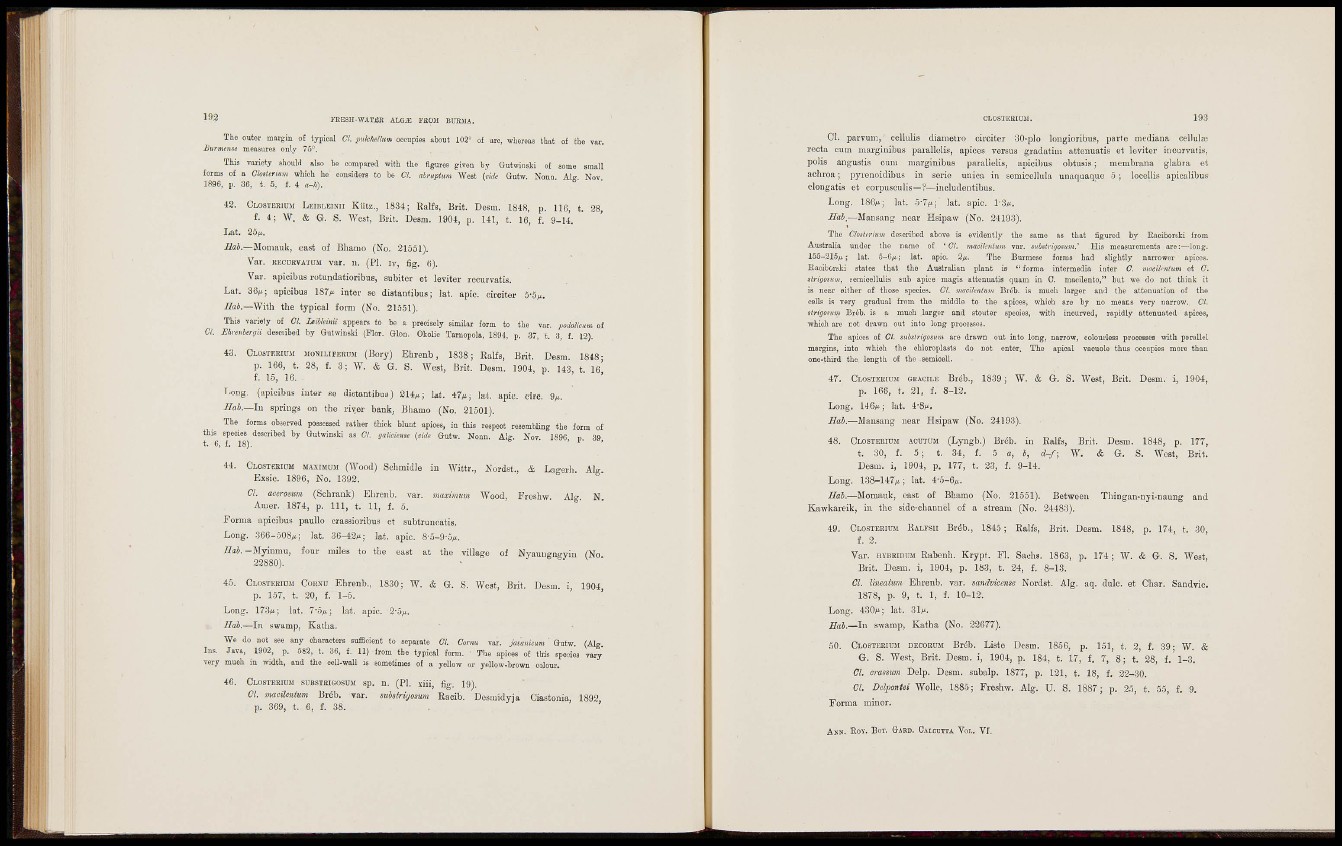
KEESII-\VAT£K ALG^ FHOJI BURMA.
The outer margin of typical CI. puMeflnm occupies about 102° of arc, wliereos that of the var.
Burmeiise measures only 75".
This variety shoulH also be compared with the figures given by Gutwinski of some small
forms oi a Closlenum which he considers to he CI. alniptum West Icide Gutw. Nonn Ale Nov
1896, p. 36, t. 5, f. 4 a-h).
42. CLOSTERIUJI LEIRLEINII Ktitz., 1834; Ralfs, Brit. Desm. 1848, p. 116, t. 28,
f. 4; W. & G. S. West, Brit. Desm. 1904, p. 141, t. 16, f. 9-14.
I>at. 25a<..
/iai.—Momauk, cast of Blianio (No. 21551).
Var. KECURVATUJi var. ii. (PI. iv, fig. fi).
Var. apicilius rotundatioribua, subiter et leviter recurvatis.
Lat. apicibus 187^^ inter se diatantibus; !at. apic. circiter 5-5^^.
/7ai.—With the typical fomi (No. 21551).
This variety of Ct. JUibkinii appears to be a precisely similar form to the var. podoHcum of
CI. Ehyenbergii desciibed by Gatwinski (Flor. Glon. Okolic Tamopola, 1894. p. 3", t. 3, f. 12).
43. CLOSTEKIUM MONILIFERU.M (Bory) Ehrenb, 1838; Ralfs, Brit. Desm. 1848-
p. 166, t. 28, f. 3; W. & G. S. West, Brit. Desm. 1904, p. 143 t 16
i. 15, 16. r , ,
Long, (apicibus inter se distantibus) 214^; lut. 47/x; lat. apic. circ. 9/i.
Ifab.—lu springs on the river bank; Bliamo (No. 21501).
rather thick blunt apices, in this respect resembling the form of
~ Gutw. Noun. Alg. Nov. 1896, p. 39,
The forms observed
this species described by Gutwinski as Cl. galickHse
t. 6, f. 18).
44. CLOSTeEiUM MAXIMUM (Wood) Scbmidie AVittr., Nordst., & Lage rh. Alg.
Exsic. 1896, No. 1392.
Cl. acerosim (Schrank) Ehrenb. var. Jiiazimum Wood, Freshw. AIo-. N
Amer. 1874, p. I l l , t. 11, f. Ö.
Forma apicibus paullo crassioribus et subtruncatis.
Long. 366-508/i; lat. 36-42*^; lat. apic. 8-5-9'5a'.
/ i a S . - M y i m n u , four miles to the east at the village of Nyauiigngyin (No.
45. CLOSTERIDM CORNU Ehrenb., 1830; W. & G. S. West, Brit. Desm. i, 1904
p. 157, t. 20, f. 1-5. ' '
Long. 173^1; lat. 7-O/i; lat. apic. 2-5>i.
JIab.—In .swamp, Kalha.
We do not see any characters sufficient to separate Cl. Cornu var. javanicum ' Gutw. (Alg
Ins. Java, 1902, p. 582, t. 36, f. 11) Jrom the typical form. Tbe apices of this species vary
very much in width, and the cell-wall is sometimes of a yellow or yellow-brown colour.
46. ClOSTERIUM SUBSTBIGOSUM Sp, D. (PI. xiii^ gg, IQ).
Cl. imcilmtum Br6b. var. mUtrigosxm Racib. Desmidyja Ciastonia, 1892
p. 369, t. 6, f. 38.
CLOSTEillUil, 193
Cl. parvum, celhilis diametro circiter 30-plo longioribus, parte mediana cellulas
rccta cum marginibus parallclis, apices versus gradatini attenuati« et loviter incurvafis,
polis angusfis cum marginibus paralielis, apicibus obtusis ; membrana glabra et
achroa ; pyienoidlbus in serie unica in somieellula unaquaquo 5; locellis apicalibus
elongatis et corpusculis —?—iiicludentibus.
Long, 186>t; lat. 5-7,*; lat. apic. I'Sm.
/ / a i — l l a u s a n g near Hsipaw (No. 24193).
The Clostcrium described above is evidently the same as that figured by Raeiborski from
Australia under the name of ' C/. macihntum var. suhtriyosum.'' His measurements are:—long.
155-215/ii lat. 5-6/x; lat. apio. The Burmese forms had slightly narrower apices.
Eacib&rslii states that the Australian plant is "forma intermedia inter C. macilKntum et C.
strigosHm, semicellulis sub apice magis attenuatia quam in 0. macilento," but we do not think it
is near either ol those species. CL maeUentum Bréb. is much larger and the attenuation of the
cells is very gradual from the middle to the apices, which are by no meats very narrow. Cl.
¡Mgosnm Bréb, is a much larger and stouter species, with incurved, rapidly attenuated apices,
whicli are rot drawn out into k
The apices of d. substrigosum are drawn out into long, narrow, colourless processes with parallel
ns, into which the chloroplasts do not enter. The apical vacuole thus occupies more than
one-third the length of the semicell.
47. CLOSTERIUM GBAAI.E Bréb., 1839; W. & G. S. West, Brit. Desm. i, 1904,
p. 168, t. 21, f. 8-12.
Long. H6/.; lat. 4-8>t.
/Tai.—J1 ansang near Hsipaw (No. 24193).
48. CLOSTERIÜM ACUTUM (Lyngb.) Bréb. in Ralfs, Brit. Desm. 1848, p. 177,
t. 30, f. 5; t. 34, f. 5 a, h, d - f ] W. & G. S. West, Brit.
Desm. i, 1904, p. 177, t. 23, f. 9-14.
Long. 138-147;x; lat. 4-5-6^.
Hob.—Momauk, oast of Bbamo (No. 21551). Between Thingan-nyi-naung and
Kawkareik, in the side-channel of a stream (No. 24483).
49. CLOSTERIUM KALFSU Bréb., 1845 ; Ralfs, Brit. Desm. 1848, p. 174, t. 30,
f. 2.
Var. HYBKIDUM Rabenh. Krypt. Fl. Sachs. 1863, p. 174 ; W. & G. S. West,
Brit. Desm. i, 1904, p. 183, t. 24, f. 8-13.
Cl. Uneatum Ehrenb. var. smdvicense Nordst. Alg, aq. dale, et Char. Sandvic.
1878, p. 9, t. 1, f. 10-12.
Long. 430m; lat. 31^^.
Hah.—h\ s-wamp, Katha (No. 22677).
50. CLOSTERIUM DECORUM Bréb. Liste Desm, 1856, p. 151, t. 2, f. 39; W. &
G. S. West, Brit. Desm. i, 1904, p. 184, t. 17, f. 7, 8; t. 28, f . ' 1 - 3.
Cl. cramim Delp. Desm. subalp. 1877, p. 121, t. 18, f, 22-30.
CL Dclpontei Wollo, 1885; Freshw. Alg. U. 3. 188T ; p. 25, t. 55, f. 9.
Forma minor.
ABIÌ. BOT. GARD, CALCUTTA TOI,. Vf.